[/caption]
What will happen to all the inner planets, dwarf planets, gas giants and asteroids in the Solar System when the Sun turns into a white dwarf? This question is currently being pondered by a NASA researcher who is building a model of how our Solar System might evolve as our Sun loses mass, violently turning into an electron-degenerate star. It turns out that Dr. John Debes work has some very interesting implications. As we use more precise techniques to observe existing white dwarf stars with the dusty remains of the rocky bodies that used to orbit them, the results of Debes’ model could be used as a comparison to see if any existing white dwarf stars resemble how our Sun might look in 4-5 billion years time…
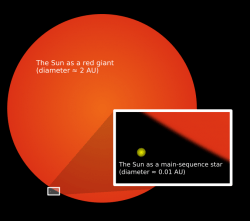
But what happens then? What happens in 4-5 billion years when the supply of hydrogen runs out in the core? Although our Sun isn’t massive enough to entertain the thought of going out in a blaze of supernova glory, it will still go through an exciting, yet terrifying death. After evolving through the hydrogen-burning phase, the Sun will puff up into a huge red giant star as the hydrogen fuel becomes scarce, expanding 200 times the size it is now, probably swallowing the Earth. Helium, and then progressively heavier elements will be fused in and around the core. The Sun will never fuse carbon however, instead it will shed its outer layers forming a planetary nebula.
Once things calm down, a small sparkling jewel of a white dwarf star will remain. This tiny remnant will have a mass of around half that of our present Sun, but will be the size of the Earth. Needless to say, white dwarfs are very dense, intense gravitational pull countered not by fusion in the core (like all Main Sequence stars), but by electron degeneracy pressure.
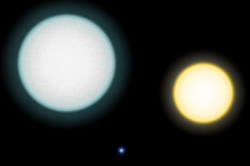
After the Sun has stopped hydrogen fusion in its core, it loses mass as it sheds its outer layers after the red giant phase and subsequent planetary nebula formation. It is estimated that the Sun will lose about 50% of its mass during this time, naturally affecting the Solar System as a whole. As the Sun loses mass, the outer planets (such as Jupiter) will drift outwards, increasing their orbital radii. In the simulation, Debes is very careful to ensure there is a gradual reduction in solar mass to ensure stability in the simulation.
What we are left with is an old Solar System, where little is left of the inner planets (it is likely that anything within the orbit of the Earth will have been swallowed by the Sun as it expanded through the red giant phase). Although the future white dwarf Solar System will seem very alien to present day, some things won’t change. Jupiter’s orbit might have receded with the drop in solar mass, it will remain a planetary heavyweight, causing disruption in asteroid orbits. Using known asteroid data, the motion of these chunks of rocks are allowed to evolve, and over millions of years, they may get thrown out of the Solar System, or more interestingly, pushed closer to the white dwarf. Once the whole system has settled down, resonances in the asteroid belt will become amplified; Kirkwood Gaps (caused by gravitational resonance with Jupiter) will widen, and according to Debes’ simulations, the edges of these gaps will become perturbed even more, making more asteroids available to be tidally disrupted and shredded to dust.
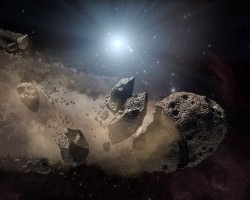
“We have a physical picture for the link between planetary systems and dusty white dwarfs,” Debes said when describing his model in relation to the mysterious dusty white dwarf observations. “Dusty white dwarfs are truly a mystery! We think we know what might be going on, but we don’t have a smoking gun yet.”
However, Debes is getting close to finding a possible smoking gun, he’s basing his model on some of the key characteristics of these ancient dusty remnants to see what the Solar System could look like in billions of years time.
So, where does this dust come from? As the asteroid orbits are perturbed by Jupiter, they may get close enough to be tidally disrupted. Get too close and they will get shredded by the gravitational shear created by the steep tidal radius of the compact white dwarf. The asteroid dust then settles into the white dwarf. The presence of this dust has a very obvious signature in the absorption lines of spectroscopic data, allowing researchers to infer an accretion rate for metal-rich white dwarfs. In Debes’ model, he has set the upper limit to 1016 g/year and a lower limit to 1013 g/year, consistent with observed estimates.
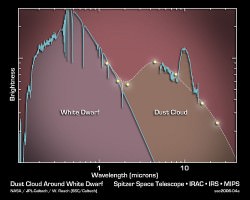
“For G29-38, the canonical dusty white dwarf, they [Koester & Wilken] estimate a total mass of 0.55 solar masses–about what people believe the mass that our own sun will have remaining when it becomes a white dwarf,” Debes added. “But mass estimates are a bit uncertain–I’ve seen estimates ranging from 0.55-0.7 solar masses for this particular white dwarf.”
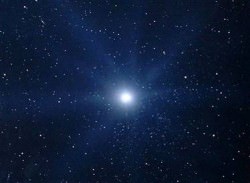
Debes is continuing to make his model more and more sophisticated, but already the results are promising. Most exciting is that we may already be observing white dwarfs, like G29-38 or WD 1257+278, giving us a tantalizing glimpse of what our Solar System will look like when the Sun becomes a white dwarf star, ripping apart any remaining asteroids and planets as they stray too close to the Sun’s tidal shear. However, it also raises the question: if white dwarfs like G29-38 are being fed by the remains of tidally-blended asteroids, are there massive planets shepherding asteroids in these white dwarf systems too?

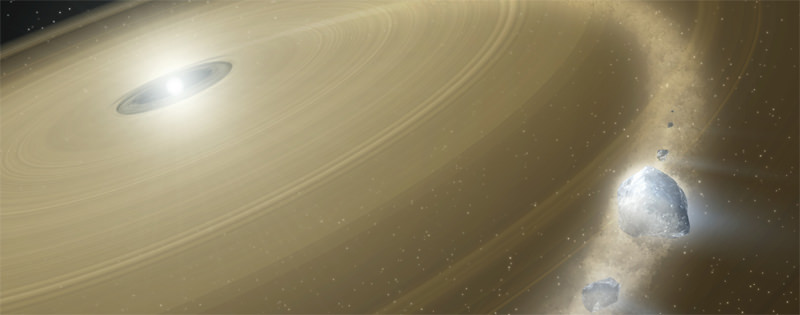
Will giants like Jupiter still have the same mass after a star has off-gassed its outer layers?
I’d think the gravity of a planet that big would rope in a fair amount of out going gas on its own. Changing its size and altering the outcome.
The outward star-wind will possibly be collected by Jupiter (and Satrun), but only the parts that come really close. The speed of the wind is already far above the escape speed for the planet, and unless it ‘crashes’ onto it, or get magnetically trapped, it will simply continute outward. I know some people will jump with joy when i say this, but plasma flows will have a big significance.
But even so, the amount gathered by either planet will be somewhat correlated to the planets angluar area as viewed from the center of the sun, i dont know the factors involved though. Could be twice the area, 10 times the area, 100 times, 1000 times…
Lets assume all outward gas passing through an angular area a 1000 times the angular area of Jupiter are accumulated. That is about 32 times the angular size of Jupiter, so quite far out, in fact that covers about 1/3 degree on the sky as viewed from the sun, and an area of 1/9 square degree.
The sky in total is about 41 253 square degrees, so only about 3 parts in a million would be grabbed. That would be about one earth-mass out of the whole sun, and only about half the sun is expected to be expelled.
The initial numbers of the capturing area are guesses, you can replace them with something more appropriate, but it does look like only a very small amount of the gasses will be caught by the major planets.
I imagine they would attract some gas from the sun. I wonder how this would effect their moons. Could it be dense enough to create drag?
And how do we know the sun is going to turn into a white dwarf?
“One part that came to maturity in the pauses between ping pong games is also perhaps the most important from the point of view of general interest. The name of this particular discovery is the Heisenberg Uncertainty Principle. It takes a strange position in regard to an ancient question, determinism. Is the future really predictable? If we knew the situation at the present with complete accuracy, then the laws of physics say that the future should be completely predictable. What Heisenberg’s uncertainty principle says is that it is impossible to know completely accurately what the present is.” — Edward Teller, physicist, 1990
OilisMastery said;
Well there is more than 20600 in number, most show gravitationall redshifts, and blow me down with a feather, some show polar fiel dstrengths between 1.5 and about 1000 MG (megagauss)
The large field measured in a white dwarf SDSS J2346+3653.
And astoundingly, there are magnetic white dwarf and non-magnetic white dwarf. Yet stone the crows, the larger objects (DB’s) are normally the ones without magnetic fields.
And of course the million dollar question is, if the sun doesn’t turn into a white dwarf, then what are the white dwarfs we observe, and more importantly if they are magnetic (whatever), what are these objects? (Dark stars?)
No let’s see strong gravitation fields and magnetic fields.
Now I wonder why that jackass Peratt never mentions this?
So have do you squeeze an object about 0.6 solar masses into an object the size of the Earth? Any magnetic strength that can compress matter to that amount must be about the field strength of literally astronomical proportion.
Actually yes, because OilisMastery will be pontificating the same old crap again and again and again.
I am wondering if that ourgassing could escape the sun’s gravity, or will it fall back some point in time?
@ Olaf
The gas will leave. Since the sun gets less and less massive, due to the loss, and the gas overcome the gravity once, it will continue to do so forever. It will become one of the fantastic planetary nebulae – although human kind will probably not observe it. 😉
Salacious,
“Well there is more than 20600 in number”
What are more than 20600 in number? And how does the number 20600 answer the question, how do we know the sun will turn into a white dwarf?
“most show gravitationall redshifts”
Most what show gravitational redshifts?
How can gravitation effect massless particles?
Newton’s formula is F = G x m^1m^2/r^2
So when I plug in mass of zero I get force of zero.
“if the sun doesn’t turn into a white dwarf, then what are the white dwarfs we observe”
Why must the observation of white dwarf stars signify that the sun will one day turn into one?
Are you going to turn into a white dwarf also?
OilIsMastery:
Do you intend to prove the universe was created by a creator ?
Excalibur,
I don’t believe in gravitation or the Big Bang.
You must be confusing me with creationists like Newton, Lemaitre, and Gamow.
By the time the Sun starts going bad, the following will have happened:
Humans will be dead, either extinct or transformed into something totally different.
The Solar System will be turned into a Dyson Shell and the Sun made to last way beyond its 10 billion year shelf life.
We will have abandoned the Solar System for “greener” pastures in the galaxy.
So this is a fun academic exercise to speculate on the future of the Solar System, but to think that the celestial neighborhood will look the same 5 billion years from now is just ignorant.
Logically it depends if the sun is actually a star.
So is our Sun a star?
(You know that the bright round object in the sky during daylight hours that hurts your eyes if you stare at it too long!)
Note: Good God, you did drop any quotes! Aren’t you well or something, eh Oils?
Oillsmastery-
Just for the record- for those of us who are new on the scene.
If you do not believe in the Big Bang- what do you believe? And do you have proof of your beliefs?
Also how old do you believe that the Universe is- 14 billion years? 6000?
Just curious
If it looks like a creationist, if it sounds like a creationist then Oils must be a creationist.
I agree Salacious, if you compare how creationists talk and spam, and if you compare how Oils talk then you must come to the conclusion that he is some type of new age creationist.
Replace Oils “Electric Universe” by the word God.
Replace Oils quotes, but quotes from the bible.
Observe the playing with semantics.
Observer how he tries to misguide with sentences that “science has nu clue, so therefore Electirc universe must be true”.
Observer the ignorance of Oils explanations about real physics and compare that with creationists so called theories of evolution like the bananaman his banana as proof that god must have created the banana.
Observer how he denies the existence of gravity and compare it with the creatinists denial of evolution
Observe his spamming.
Everything is exactly the same as a creationist would do, so I see him as some new age creationist.
Hi Olaf and Folks,
I have finally discovered OilisMastery’s “Philosophical Doctrine”. It is Hippolytus, Refutation of All Heresies: On Democritus,
The link is; http://www.ccel.org/ccel/schaff/anf05.iii.iii.i.ii.html
The follow summaries his techniques and why he behaves as he does. Much of it can be turned against him. For example;
“We must not overlook any figment devised by those denominated philosophers among the Greeks. For even their incoherent tenets must be received as worthy of credit, on account of the excessive madness of the heretics; who, from the observance of silence, and from concealing their own ineffable mysteries, have by many been supposed worshippers of God.”
— Hippolytus, priest, Refutation of All Heresies: On Democritus, 2nd century
The fool now stands naked and exposed…
Oil when poured on the hand, for the most part, spreads through ones fingers. He is now becoming a Master of an exposed doctrine. [BIG MISTAKE]
Got any more interesting quotes hey Oils?
Those interested might like to read the last line of the link above;
“Assigning to each of those who take the lead among philosophers their own peculiar tenets, we shall publicly exhibit these heresiarchs as naked and unseemly”.
— Hippolytus, priest, Refutation of All Heresies: On Democritus, 2nd century
Applicable to anyone we know, do you think?
Oils is a Plasma Universe acolyte with a streak of Thunderbolts/Velikovsky thrown in by the sounds. Velikovsky never did understand gravity and he decided everything was done with electromagnetism – he wrote an essay that “did away with gravity” in the 1940s and ever since Moon-bats have carried on about how gravity doesn’t really exist and it’s all static charges or some such garbage. The fact that there’s absolutely zero evidence for anything Velikovsky actually theorised (rather than plagarised like any of his “successful” predictions) hasn’t ever stopped his unthinking legions of admirers from being dissuaded from their faith that mythology should dictate science.
I agree with Graal, Oil proves again and again that he is very ignorent, so he reverts to what he does know at the limit of his own understanding and try to fit eveything with the oversimplified understanding he has.
And then he also tries to hide the fact that he has not even the most basic understanding of physics by trying to impress us with quotes and technobabel hoping that we would not check any clames ourselves. Add this with the multiple of other alias names he uses so ge generates a so called discussion with 2-3 people but in reality he is only one!
What I still do not understand why is he so stupid enough to do this on a science site? On a holistic site he would have some credibility, but here he gets debunked instantly as a fool.
graal
Oils is no longer talking it terms of science. In fact he is still one of the remaining few among the fossilised Natural Philosophers who long ago disappeared in the dust of early 18th Century.
His own blinding doctrine is apparently Oils distorted view of world – a world that is full of illusion and deceit !
Salaciousn can you explain it is simple lifeform terms. 😉
A bit too abstract your explanation of Oils for me.
Do you mean he is religious and wants to get rid of all heritics?
Layman,
“If you do not believe in the Big Bang- what do you believe?”
See here: http://www.bigbangneverhappened.org/
“…their theory is incorrect but they don’t have an accepted theory to replace it and that I think is very psychologically bothersome to particularly scientists who have gone into science in order to be certain about the world, to be sure that they’re right and so forth, and it’s a very insecure position. Some scientists have joked that well a scientist would rather be wrong than uncertain. We sort of have to live with uncertainty which is, well, it’s an interesting and challenging situation.” — Halton C. Arp, astronomer, 1998
“And do you have proof of your beliefs?”
Yes. Electrons and electricity have been observed and tested. They are not just a little trick that you can repeat in the lab. All matter is coposed of electricity and all inertia of electromagnetic origin.
“Also how old do you believe that the Universe is- 14 billion years? 6000?
Just curious”
I have never observed the entire universe so I can’t comment on it’s age. Time is a priori so I’m not sure the universe even has an age.
Oillsmastery- Thank you for setting us straight on your beliefs.
I read your recommend sight-bigbangneverhappenen.org
I am not a scientist and to be perfectly honest this is my first view of Plasma theory- Most of it is way over my head.
It does go against popular thoughts of currently accepted conventional scientific wisdom.
I have always had a problem with Inflation theory just to make the Big Bang math work- It may well be correct, but how can we ever prove it? In my mind this becomes more like religion- I want more than a faith based science.
What I do know is that it appears that we live in a very large Universe and that we may never know what happened before there was nothing. Black holes seem to exist whether you like it or not. Gravity seems to hold things together or push them apart. Dark matter/dark energy- time will tell…..
We will talk about this again in 5 or 10 thousand years and see what has been learned.
keep givin’ them hell oills!
i’m not all that into your plasma theory, but i do like how you are never afraid to question the limits of what we know.
Layman,
“Black holes seem to exist whether you like it or not.”
Where? In Meinong’s Jungle?
“…the ‘Schwarzschild singularities’ do not exist in physical reality.” — Albert Einstein, mathematician, 1939
“Even mainstream scientists admit that at singularities the ‘laws of physics’ break down. It would be more accurate to say that their own theories break down.” — David Pratt, natural philosopher, 2005
I can’t find anything verifying the existence of the David Pratt fellow you speak of, except for quotes which seem to indicate he’s strangely inline with fringe physics. I can see that your quote there is properly attributed to Marcus Chown of New Scientist though. Of course, he’s talking about how our current theories are incomplete and need more refining, i.e. a quantum theory of gravity. Chown (and not this likely non-existance Pratt fellow) isn’t saying that black holes don’t exist.
Popisfizzy,
“I can’t find anything verifying the existence of the David Pratt fellow you speak of, except for quotes which seem to indicate he’s strangely inline with fringe physics.”
I agree with you characterization of Albertin Einstein and General Relativity as “fringe physics.” However, Einstein happened to be correct about black holes.
“I am inclined to think that physicists will not be satisfied in the long run with this kind of indirect description of reality, even if an adaptation of the theory to the demand of general relativity can be achieved in a satisfactory way. Then they must surely be brought back to the attempt to realise the programme which may suitably be designated as Maxwellian: a description of physical reality in terms of fields which satisfy partial differential equations in a way that is free from singularities.” — Albert Einstein, mathematician, 1931
Oooh, and twisting words now, eh? You’re rather good at being a crank. Of course, I was talking about quotes from “him” (as attributed by a person with your mannerisms, meaning it was likely you) believing in the expanding Earth theory, which is fringe because there is no viable method for expansion.
And Einstein dislike black holes because of singularities, which is considered a problem in modern physics, likely remedied by a quantum theory of gravity. Of course, he didn’t believe quantum mechanics either. Einstein, and all physicists, are hardly infallible. But they’re certainly less fallible than you, with your quoting and rambling and ignorance and lack of evidence. Silly little man. 😛
I hope this doesn’t sound stupid but if the orbits of the outter planets change wouldn’t the inner planets orbit change?? Perhaps pushing earth into a deeper orbit so it wouldn’t be consumed?
Sir Arthur Wellesley:
Correct, as the Sun is expelling mass, all orbiting planets will slowly migrate outwards.
However, as the sun is also expanding, some of the inner planets might get atmospheric ‘drag’ that makes them loose orbital momentum aswell. Inside some limit they would therefor migrate inwards and end up being swallowed.
Olaf Says (about OilIsMastery):
“On a holistic site he would have some credibility,”
I don’t believe he would. His views often come across to me as reductionist, insular and and protectionist.
I very strongly believe in holism – a belief which provides the basis for my fascination with science, my fascination with observing how the “Big Picture” never quite allows itself to be drawn by “joining the dots”, no matter how precisely those dots are positioned, and how many of them can be defined.
OIM, on the other hand, in a manner of speaking, seems to consider a picture he likes and search for dots, which he then claims can be joined to produce the chosen picture.
I can see some mainstream scientists driven by reductionist thinking – others driven by holism… and I continue to be fascinated while looking in awe at the Universe around me….
… and I continue to drift off-topic. My apologies, but at least I’ve got this niggle off my chest now.
Feenix
I do agree with everything you said in the above post except that you did not go far enough. I.e.
In truth, the most successful among scientists and engineers, and indeed partly in the practical sciences, are the ones who can easily switch between holism and reductionism in their thinking – then apply it to the situation requires. Being involved in investigation often need formal and apt application of the scientific method, but every now and then you must look at where it fits into the big picture. Here lies the spark of inspiration, whose insight leads to different ways of thinking or new avenues to explore. For example, Einstein and others seem adept to the switching between these two scientific philosophies. (I.e. The applications passing of trains relative to one another in the experienced part of the world and the when travelling at light speed. Found later in say the increased mass of a proton as it is accelerated to near light speeds.) Also, such ways are often seen with scientists or engineers who are also brilliant in formal education.
I am more amazed at some of the scientists, and many cosmologists who are just fanatical purists of just reductionism. General characteristics are ones who are diligent in the data produced and the painstaking analysis to draw the correct logical conclusions. However, most fail dismally in how their work fits into others or the branch of science they specialise.
Holism is also useful in examining various cracks in theory, and then assessing which one is the best option to discover new concepts or avenues to deeper understanding.
Oils is vulnerable because he absolutely fails to see the true meaning of the scientific method and the reasoning behind it. Instead, he rejects it outright and relies on crazy faith-based philosophies as the means of defining truth. Those who do not follow the path based on doctrine must be wrong (heretical thinking), so the purpose is to expose the weaknesses of accepted Theory – and finding one fault then completely rejects the whole notion of that theorem. I.e. Gravity waves have not been found, therefore gravity doesn’t exist at all. Hence for him it is all or nothing, when the reality is we understand what we perceive as the consequences of mass and the force it exerts very well, but we have yet to absolutely determine the manner of transmission that gives mass its characteristic signature.
The classic example of holism, which exposed Anaconda’s weakness in understanding, was Noether’s Theorem – in which Emily Noether importantly joins the physical systems of symmetry to their corresponding conservation laws. She, for example, is a prime candidate for the profound insight of things through holism. This was help no doubt to the sexist world of science 100 years ago, who applied an missed insight into nature on behaviours of most physical systems.
AJames says:
[quote]In truth, the most successful among scientists and engineers, and indeed partly in the practical sciences, are the ones who can easily switch between holism and reductionism in their thinking – then apply it to the situation requires.[/quote]
Bang on, enough said!
Thanks for filling in the “missing bit” in my post.
🙂
Excalibur
Thanks for the reply, interesting stuff indeed!
Feenix.
Here is a definitive quote by Einstein towards holism that might help you;
(Just don’t tell Oils…)
Cheers